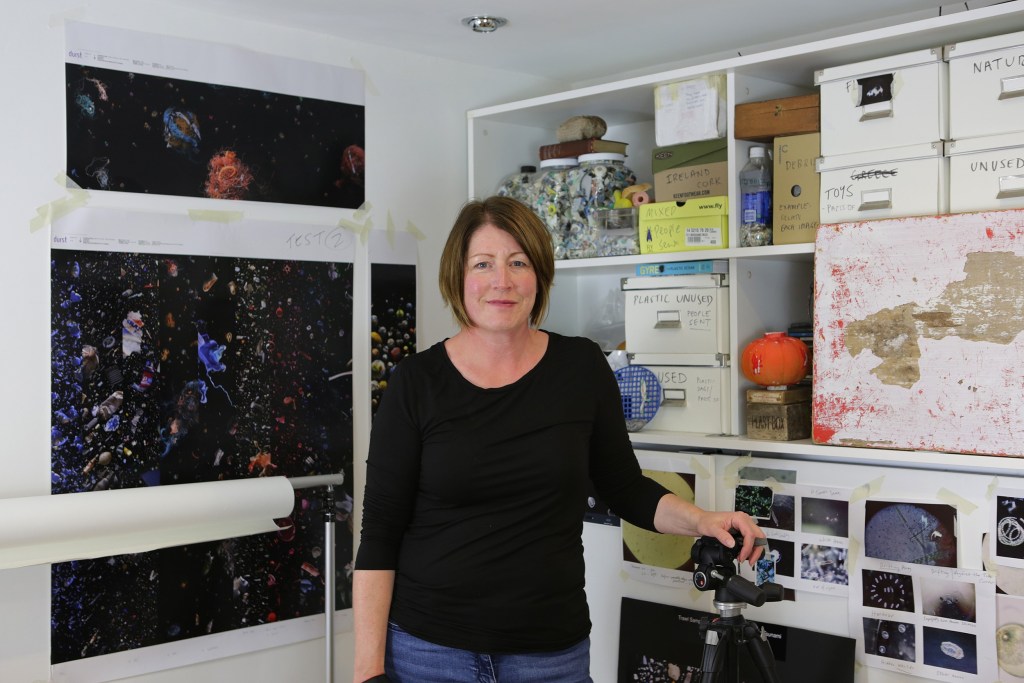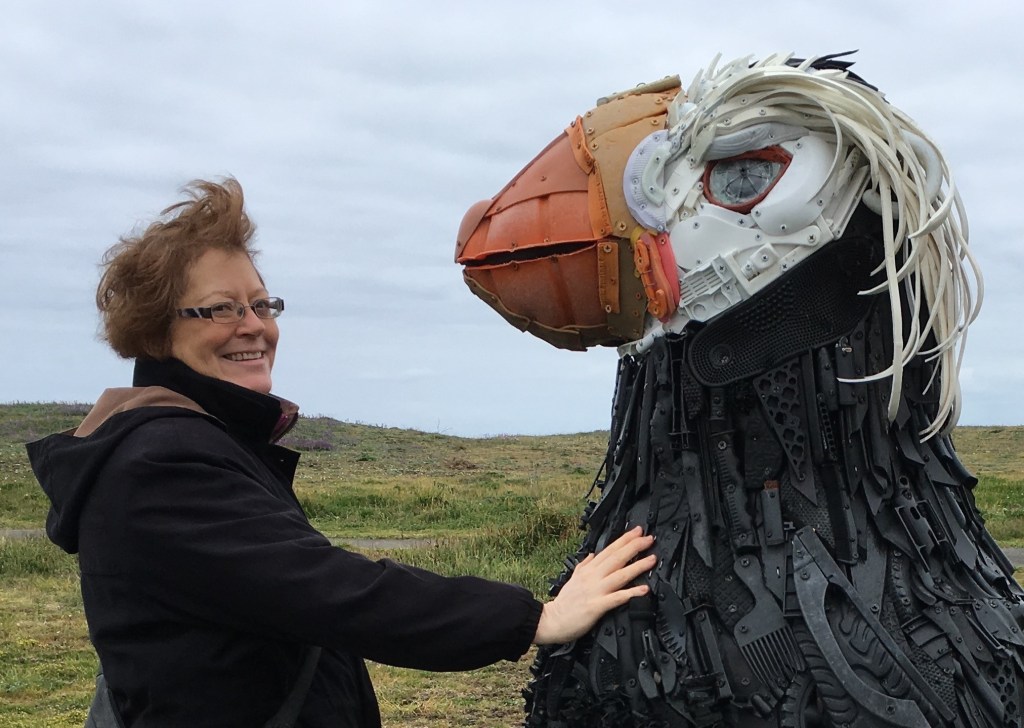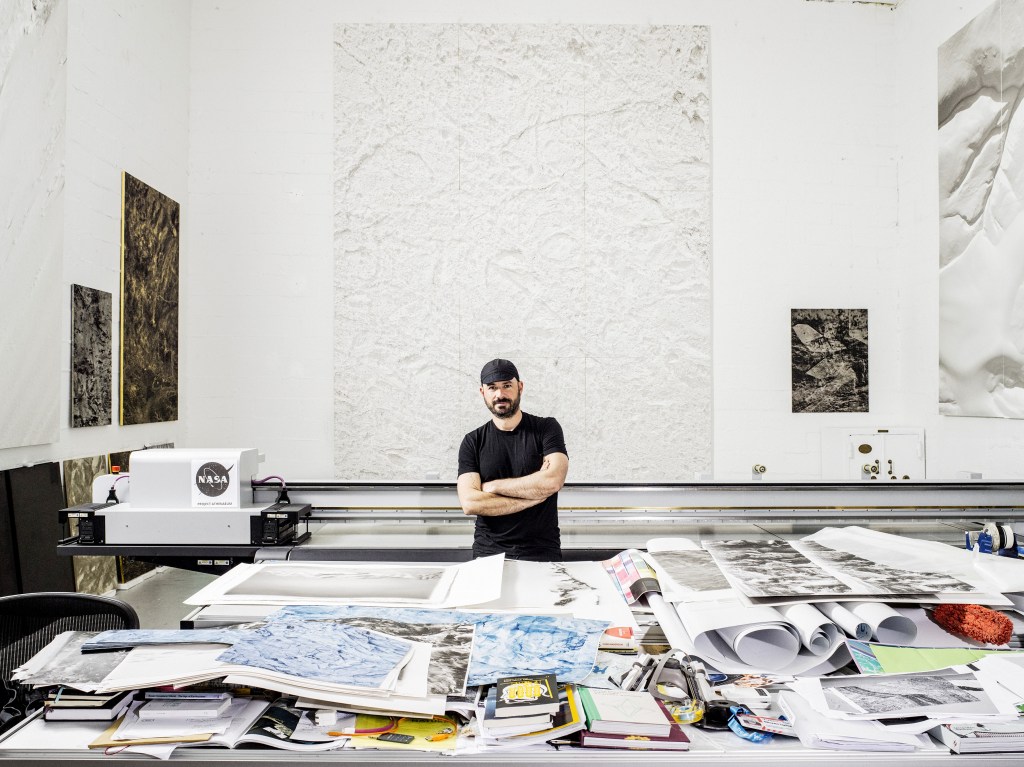Some people take action against climate change by tweaking personal habits, like flying less, switching to renewable energy or using public transportation. Others take to the streets to demand action from policymakers. And then there are those who take a more creative approach to their advocacy, marrying their art with environmental savvy to capture attention and spark discussion.
Artists are among the increasing number of people taking action to protect the environment. Here are four making their own splash with creative advocacy, whether it’s crafting sea creatures from pollution or photographing ocean debris.

Artist Mandy Barker poses in her studio.
Mandy Barker
Award-winning international photographer
Mandy Barker grew up in Hull, England, combing nearby rocky beaches for vacant shells and fragments of wave-worn glass. As decades passed, the ocean tide began bringing in a different find: plastic garbage. The English shores were littered with everything from small, confetti-like plastic fragments to large objects like refrigerators and freezers.
Inspired to teach people about plastic pollution impacting marine life, in 2009 she began photographing the washed-ashore pollution. But no one really paid attention to her pictures at first, she says. She guessed people were already so accustomed to seeing trash in motorways and on sidewalks that the journalistic images didn’t stand out.
To get people to take notice, she brought the plastic pieces to her studio and made mosaic patterns of the colorful pollution on a black, velvet background. Not only did it make the garbage pop, the contrast made the objects appear as if suspended in space. It’s a nod to the idea that plastic’s lifespan and impact can seem just as infinite as the universe (it can take hundreds of years for plastic to decompose).
“This seems to have worked because in 2011 my images kind of went viral,” she says.
In the past decade, Barker has published her work in more than 40 countries, including at the United Nations headquarters in New York.
“Photography is such a powerful way of communicating something,” she says. “[It] has no boundaries in terms of language.”
Barker often combines her art with text from scientists about the plastic pollution problem. This hits home for many. She says it’s not uncommon for people to leave her exhibits crying. That’s what Barker wants: for her art to mean something.
“I want it to educate people,” she says. “I want it to inform them about what’s going on.”

Kendler is a Chicago-based artist. (Photo Credit: Clayton Hauck for Chicago Reader)
Jenny Kendler
Environmental artist and advocate
One of Jenny Kendler’s most notable sculptures—a co-creation with fellow artist Jeremy Bolen—is of a vintage white lawn chair perched atop 100 life-ring buoys. Unlike her other pieces, it’s done some solo traveling, having floated the confluence of the Mississippi and Ohio rivers. The journeying piece is a nod to many things: the rising sea level, vulnerable climate refugees and the nonchalant, lawn-chair-reclining attitude some adopt toward climate change.
Kendler, 39, says the project, titled Lounging Through the Flood, asks people to think: “Are you going to be active? Are you going to survive? Or are you going to pretend like [climate change] isn’t happening?”
Kendler saw from a young age the impact of environmental action. Her mom helped design her family’s solar-powered home in Virginia. Her grandmother founded an environmental nonprofit, Mothers for Peace. The family discussed climate change at the dinner table. A young Kendler often penned petitions for environmental causes.
“It was such a normal part of my life,” she says of her climate-conscious upbringing.
Now, she’s an art coordinator for Extinction Rebellion and is the first artist in residence with the Natural Resources Defense Council. More importantly, she creates. And her projects—most of them sculptures—tackle tough subjects like climate change.
The life rings from her traveling sculpture eventually will be removed and used by Extinction Rebellion Chicago as props at a future demonstration. After, they’ll be auctioned to raise funds for flood relief.
“I think that ultimately the baseline issue behind the climate and environmental, ecological crisis is culture. … We [have a] system that over exploits the Earth,” Kendler says. “I think one thing that art does really well is show how [life] might be otherwise.”
Kendler’s work has been featured at New York’s Storm King Art Center, the Museum of Contemporary Art Chicago and the Pulitzer Arts Foundation, among others.
In addition to creating, she encourages others to use their talents to effect a positive change.
“I think there’s this idea that we’re powerless, [and it] is foisted upon us by a culture that wants us to think of ourselves only as consumers instead of creators,” she says. “I just reject that.”

Angela stands next to Cosmo the Tufted Puffin, installed at the Oregon Islands National Wildlife Refuge at Coquille Point in Bandon, Oregon. (Photo credit: ©WashedAshore.org)
Angela Haseltine Pozzi
Sculptor and founder/artistic director of Washed Ashore
This 62-year-old sculptor has long had a hand for art, having taught the subject for three decades. But she didn’t begin creating for herself until about 2009. At the time, Angela Haseltine Pozzi had recently lost her husband of 25 years to a brain tumor. To heal, she retreated to the Oregon coast, a place where she spent many of her childhood summers. It was there that she first began noticing the amount of discarded plastic covering the shores.
“I would walk my dog on the beach every day and kept stepping on garbage, and I didn’t want to see it because I didn’t come there for that,” she says. “I came to see beauty and to heal.”
But Haseltine Pozzi couldn’t ignore it, and she soon began cleaning up the debris and researching the problem. Along the U.S. coastline alone, the National Oceanic and Atmospheric Administration estimates there are between 20 million and 1.8 billion pieces of plastic. Frustrated by how the garbage was harming marine habitat, she took a stance: She wouldn’t buy any new materials for her art projects. Instead, she’d use the plastic she gathered from the beach to create sculptures to show people how much plastic is in the ocean (people add an estimated 8 million tons annually) and how it’s harming marine animals.
Soon after, she decided to start a nonprofit to support her work and engage communities in beach cleanups. Using settlement money from a medical malpractice lawsuit (her late husband initially was misdiagnosed), she bought a house on the Oregon coast and financed the first two-and-a-half years of her nonprofit.
“I was handed this big chunk of money, and I thought, ‘What am I going to do with this?’” she said. “‘I have to do something important.’ That’s when I came up with the idea of [my nonprofit], Washed Ashore.”
It felt like a meaningful way to honor her late husband, also an art teacher. Today, Haseltine Pozzi says more than 25 million people have viewed her artwork in person, and it’s been exhibited in more than 30 locations, including at the UN Ocean Conference in 2017 and at the U.S. State Department.
“I was once a millionaire who started a nonprofit in order to save the world,” she says with a laugh. “And now I feel like I’ve made good use of that money.”

Photo credit: ©Noah_Kalina
Justin Brice Guariglia
Visual and conceptual artist
New York City-based artist Justin Brice Guariglia believes that creating art centered on climate change is a political choice. He believes the same about creating art that doesn’t focus on climate change.
“Fifty years ago, aesthetics could drive the conversation,” he says. “Today, if I were to focus on aesthetics, I feel I would be neglecting my responsibility … by not addressing the greatest threat to organized human life that society has ever faced.”
Guariglia doesn’t shy from tough climate conversations or unique expeditions that can inform and inspire his art. He has flown missions with NASA to photograph Greenland’s melting ice sheets. He’s joined scientists in the Alaskan tundra as they studied the Arctic’s thawing permafrost. He’s printed glaciers in acrylic on polystyrene because polystyrene, unlike glaciers, will be around forever. He’s used LED boards to share messages like, “Goodbye Arctic Ice.”
Before he became an artist, he worked as a photojournalist for two decades in Asia, predominantly based in China. While there, he saw the country’s rapid economic growth and the subsequent cost to the environment. That inspired him to take action. Eventually, he pivoted to creating art because he felt his photos alone were too limited a way to talk about the topic.
“I felt a need for making objects because the vocabulary was so much more open, and as a result, more complex and multidimensional,” he says.
Art also gave him a chance to focus on action. Photography, by default, captures something that’s already happened, he says.
“We so desperately need art today to help us reimagine our future and find a better way forward.”
